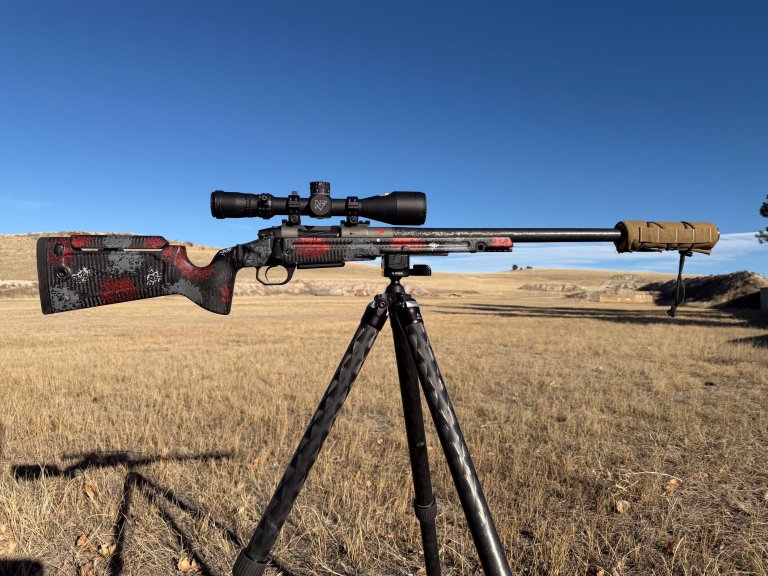I’ve been shooting and hunting with the Nemo Electus a lot this fall and am pleased to report that we are getting along swimmingly. This doesn’t come as a surprise, given the rifle’s origin story. It is the brainchild of Jeff Sipe, president of Nemo Arms, who set out to develop the best possible bolt-action for technical Western hunters — something that is compact and light enough to haul around the mountains all day, can shrug off hard use and still perform at a high level, readily adapts to various shooting scenarios, and is dead-nuts accurate.
Full disclosure, Jeff and I are very good friends, and while I wouldn’t go so far as to say that I had a hand in the design of the Electus, I can tell you that Jeff and I have spent many hours discussing what makes for a great hunting rifle and share similar views on what we want. The point is, if I were to design a high-end hunting rifle with best-in-class features, it would look a lot like what you see here.
Nemo Electus

Pros
- Accurate
- Well balanced
- Lightweight
- Rugged
Cons
- Expensive
Specs
-
Cartridge
6.5 Creedmoor (Also available in 6.5 PRC, 7 PRC, 7 Backcountry, and 300 PRC) -
Action
Two-lug titanium Zermatt Ti3 -
Stock
Manners folding carbon fiber with adjustable cheek piece -
Barrel
Proof Research 20-inch carbon-wrapped, threaded 5/8-24 -
Trigger
Triggertech Diamond (1 pound, 7 ounces, measured) -
Weight
6 pounds, 14 ounces (measured with empty 4-round magazine) -
Price
$7,885
Key Features
Integral ARCA rail on fore-end
20 MOA split Picatinny rail
Lightweight adjustable cheek piece
Flush inset Picatinny rail on fore-end
Five QD cups
Nemo Electus Accuracy
The Electus is a seriously accurate rifle. I’ve put a little over 200 rounds through the rifle, and have gathered data on numerous loads. Two factory rounds in particular have stood out. Federal 130-grain Berger OTM, a match round, averaged .405 inches for five-shot groups, and when aggregated into a 20-shot group the extreme spread was .92 inches with a .22 inch mean radius. Equally impressive was the Federal 143-grain ELD-X load. The five-shot group average for that was .545 inches also with a .22 inch mean radius, and the 20-shot group measured .95 inches.

A Note on Outdoor Life’s Accuracy Protocol
We shoot multiple five-shot groups on a specially designed target that allows us to easily combine them into a single 20-shot group with the help of an analysis app. We record the average of the five-shot groups and measure the extreme spread of the 20-shot group. The app also calculates the mean radius of the 20 shots, which is the most meaningful accuracy metric.
The mean radius is the average distance from the center of the group that the bullets hit. A mean radius of .30 inches or less is very good for a hunting rifle, while anything .25 inches or less is excellent. For a top-level competition rifle, any mean radius value of .20 inches or less is outstanding.

Lightweight and Packable
The Electus makes generous use of weight-saving materials, specifically carbon fiber and titanium. The two-lug action is a modified version of the Zermatt Ti3, made specifically for Nemo. One of the things that elevates this action above many other titanium offerings is how smoothly it runs. It is fairly common for titanium actions to be a bit sticky and subject to bolt chatter when you run them fast, especially if the action is at all dirty. It’s simply the price you pay for the weight reduction. But not all titanium actions are equal, and the Zermatt Ti3 is one of the slicker ones out there. Give credit to the spiral fluted bolt that is DLC coated. Both features help with the action’s glassy feel.
Nemo opted to use carbon-fiber wrapped Proof Research barrels on the Electus, which are still the best out there when it comes to meaningful weight reduction without compromising accuracy. Proof’s cut-rifle barrels deliver consistently good results, even on competition guns — as in the NRL Hunter series — where the pace of fire far exceeds what any hunter will likely engage in.
One thing to note is that Nemo is planning to produce their own carbon-wrapped barrels before long, so at some point the Electus (and future offerings) will sport home-grown tubes.
Then there’s the stock. Sipe went with a new carbon-fiber folder from Tom Manners. The model is the MCS-PPF-A, which is a mouthful, but stands for Manners Composite Stocks Pro Pack Folder-Adjustable. Depending on the recoil pad used and a couple other details, this stock comes in at 36 to 38 ounces, more or less. At just 2 ½ pounds it crams in a lot of great features, including an adjustable cheek piece, a strong and easy to deploy folding system, integrated ARCA rail along the bottom of the fore-end, a flush mounted Picatinny rail, and multiple QD sling attachment points.
In the folded position, the rifle measures just 28 ½ inches from muzzle to the back of the hinge. The objective bell on my scope — a Nightforce NX8 4-32×50 — extends past the hinge a bit, so with the optic on board that folded length increases to 30 inches on the nose.
Accuracy and Velocity Testing
I’ve tested plenty of lightweight rifles with folding stocks in recent years and I can tell you that it can be difficult to get them to shoot well. All things being equal, a lighter rifle is more difficult to control and shoot accurately, plus a hinge on a stock can be prone to flexing, which can affect accuracy.
I got my rifle in 6.5 Creedmoor because of that round’s proven track record for precision and because with the right bullet selection it is capable on big game from antelope to moose.
During my accuracy testing with a variety of factory loads the Electus demonstrated its shooting chops. A couple of the standout loads are Federal’s 143-grain ELD-X, which is an excellent long-range hunting bullet, and the 130-grain Berger OTM, which is also loaded by Federal. I’ve also been impressed with the 140-grain Fusion Tipped, which has quickly become a favorite hunting round of mine, and is what I used on the hunt I write about below.
| Ammo | 5-Shot Group Avg. | 20-Shot Group ES | Mean Radius | MV (fps) | ES (fps) | SD (fps) |
|---|---|---|---|---|---|---|
| Fed. 130-gr. Berger OTM | .405 in. | .92 in. | .22 in. | 2694 | 95.7 | 19.2 |
| Fed. 143-gr. ELD-X | .545 in. | .95 in. | .22 in. | 2639 | 68.2 | 16.1 |
| Fed. 140-gr. Fusion Tipped | .820 in. | 1.16 in. | .39 in. | 2597 | 76.6 | 19.1 |
| Hrn. 147-gr ELD-M | 1.10 in. | 1.56 in. | .46 in. | 2637 | 75.2 | 18.9 |
Velocities from the 20-inch barrel with the 140-grain Fusion Tipped were just a tick below 2600 fps, while the 130-grain Bergers averaged 2694 fps. Interestingly, the 143-grain ELD-X bullet, also loaded by Federal, shot a bit faster than the 140 FT, averaging 2639 fps. The standard deviation (SD) on all these loads was consistently in the high teens (16 to 19 fps), which is good for 20-shot strings with factory ammo. Velocity data was gathered with a Garmin Xero C1 Pro chronograph.

In The Backcountry
I spent a week in the Idaho backcountry hunting elk with the rifle. I was hunting with Sipe and some other friends in the Pioneer Mountains, which is in the rugged (and aptly named) Sawtooth National Forest. Most of that time I was in a saddle, cruising around from one spot to the next to glass for critters.
With the rifle in my scabbard, I was able to fold the stock down, which kept the butt from wanting to jab me in the chest. I usually think about folders being an advantage when strapping a rifle to a pack, but it turns out it is useful when mounted as well.
The stock’s folding mechanism is actuated by a large button on the left side of the gun that’s easy to depress but is also recessed so it won’t get pushed accidentally. The stock has magnets embedded in it that click together when the stock is folded to retain it. Deploying the stock is nearly instantaneous as you just need to break the magnetic bond and the butt swings into the extended position. I wouldn’t mind a slightly more secure retaining system, but I like that you don’t have to take any extra steps to get the rifle into action.

The rifle is a pleasure to hike with too. It is easy to lash to a backpack for longer climbs, but I also had it configured so I could hang it from the strap of my pack with a connector designed for that purpose. (I won’t go into too much detail here, but if you’re interested, check out OBi Systems, which makes this gear.)
Versatile Shooter
Ideally, whenever we hunt we want a steady prone position to shoot from, but that’s often doesn’t pan out in the field. The flat-bottomed fore-end and integral ARCA rail on the Electus let you clip into a tripod or rest the rifle on a rock or tree in conjunction with a shooting bag to get stable. If you’ve ever run a rifle in a field match that emphasizes positional shooting, you have a sense of how steady you can get. I place a lot of value on a rifle that lets me leverage those techniques, which the Electus does.

That said, I did manage to get prone when it came time to shoot my elk, which was in a clearing across a canyon formed by the Little Wood River. This was just past first light, and the air was calm, so I felt confident in taking that several-hundred-yard poke.
The bipod I’m running is the MDT Backcountry, which is the best lightweight hunting bipod currently on the market. It is light, has a wide range of adjustability, is stiff and stable, and deploys quickly. For the price, $299, it is a hell of a deal given the level of performance it delivers. Paired with an Armageddon Gear Shmedium Game Changer stuffed with Git-Lite fill, which is my go-to rear bag for every hunt, I was able to get a rock-solid position.

Excellent Terminal Ballistics
I mentioned how impressed I’ve been with the Federal Fusion Tipped bullet of late. I’ve been using it extensively for testing rifle accuracy — it is about the most accurate bonded hunting bullet out there right now — and have killed a couple animals with it, including a bull elk last year in the 7mm Backcountry, and this tank here.
There’s a lot of controversy about the 6.5 Creedmoor’s capability on big game, which is understandable. But with the right bullet selection and good shot placement it is utterly lethal on game. I won’t recount how many large critters I’ve taken with the 6.5 Creed, but it is a pile, including a bunch of elk. I’ll admit that I pushed this shot to the limit — my impact velocity was about 1,580 fps according to my ballistic solver, which is on the edge of reliable performance. (Most bullet manufacturers advertise a minimum impact velocity around 1,700 fps or so for consistent expansion. In practice, cup and core bullets can be counted on when they hit when going at least 1,600 fps.)
But as you can see from these bullets, all of which were recovered on the offside of the bull, they did their job. They expanded well, penetrated like crazy, and dropped the battle-hardened 7×5 where he stood.

Other Observations
A couple more things about this rifle are worth mentioning. The M5 DBM bottom metal, from Mack Bros, is one of my favorite designs. The ambidextrous tabs are integrated right into the trigger guard, so you don’t need to place your finger inside the trigger guard to drop the magazine. The spring in the tab is stiff enough to prevent it from accidently getting bumped but doesn’t require much effort to manipulate. The magazine sits nearly flush on the stock and holds four rounds.
I mentioned the rifle’s 20-inch barrel before but didn’t elaborate. As the use of suppressors has become more common, we’re seeing rifles shipping with shorter barrel lengths to prevent the gun from becoming unwieldy. The Electus is designed with suppressors in mind, which is a smart move.
I paired mine with the excellent Thunder Beast Ultra 7, which is one of my favorite lightweight suppressors. But if you watch the video (above) I did on the rifle, you’ll see I highlighted another silencer, which is Airlock Industries Zero Gravity, an intriguing can printed from titanium that is amazingly light (5.7 ounces), short (under five inches), and super quiet.

The rifle’s five QD cups is another forward-looking feature. I’ve railed against old-school swivel studs for years now, and it warms my heart to see more rifles like this one sporting flush cups, which are stronger and less snaggy.
As befits a rifle with such a price point, it comes with a lovely trigger, in this case a Triggertech Diamond, which is adjustable down to 8 ounces. (I don’t recommend going that low on a hunting rifle, by the way.) Nemo is shipping them set to break at 1.5 to 2 pounds, which is plenty light for a big-game rig.
I’d be remiss if I didn’t praise the rifle’s overall handling too. One benefit of pairing it with the light suppressor and bipod is that even when those accessories on board the Electus balances well. Often, adding that weight up front will make a rifle muzzle-heavy to the point of it becoming unwieldy.
That isn’t the case here. The Electus remains nimble despite the presence of those accessories and is what all suppressed rifles should aspire to.
Final Thoughts on the Nemo Electus
Nemo set out to create the best hunting rifle they could, not matter the cost. Yes, the Electus carries a hefty price tag. But in terms of the quality of its build, fine ergonomics, advanced design, and overall performance, it is among the best hunting rifles currently offered.
The post Nemo Electus: A New Premium Bolt-Action For Big Game appeared first on Outdoor Life.
Whitecounty.com Appreciate the great content from Outdoor L:ife





